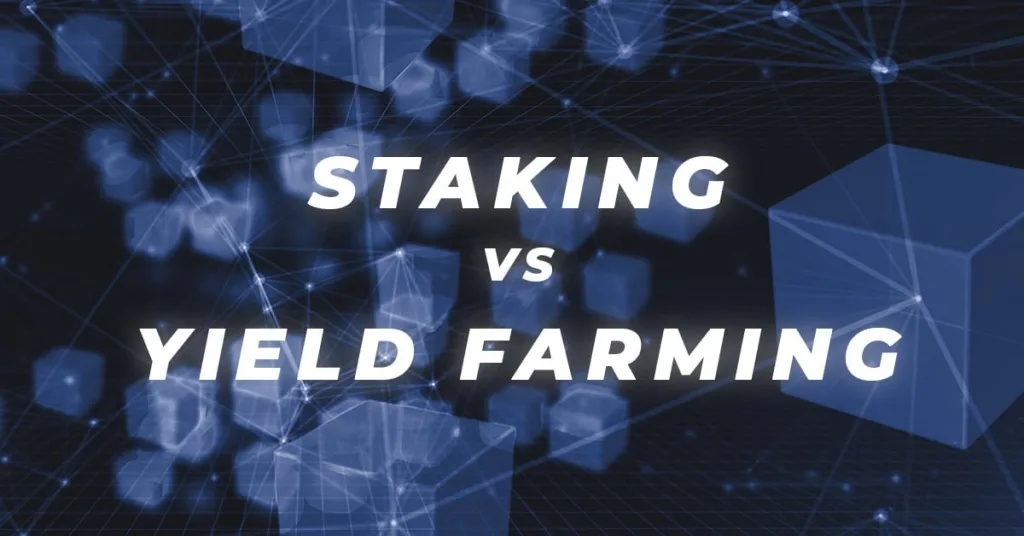Exploring Staking & Yield Farming: Profit Opportunities in DeFi
Staking and Yield farming offer exciting ways to earn rewards in the DeFi space. In this article, we’ll explore how these strategies work, their benefits, and how they can help you maximize your crypto returns.

WHAT IS STAKING?
Staking is a process where cryptocurrency holders lock up their assets to support a blockchain network’s operations. In exchange for this contribution, stakers earn rewards in the form of additional tokens. This mechanism is commonly used in proof-of-stake (PoS) consensus algorithms and variations like delegated proof-of-stake (DPoS). Essentially, staking is a way for cryptocurrency owners to participate in network security and earn returns on their investment.
Key Points on Staking
Security and Validation: By participating in staking, individuals contribute to the overall security and validation of transactions on the blockchain, ensuring the network’s integrity and robustness.
Rewards: Stakers earn rewards in return for their contribution, typically receiving payouts in the same cryptocurrency they have staked. This incentivizes participation and helps maintain the blockchain’s functionality.
Consistency: Staking rewards are usually more stable and predictable compared to other forms of passive income, providing a reliable way to generate earnings in the cryptocurrency market.
WHAT IS YIELD FARMING?

Yield farming is a process where users, known as “yield farmers,” lock up their cryptocurrency assets in liquidity pools or decentralized lending platforms to earn rewards. These rewards can come in the form of governance tokens, trading fees, or extra interest on their staked assets.
Unlike staking, yield farming is more complex. Yield farmers actively look for the best earning opportunities across different platforms and often move their assets frequently to maximize their returns.
As a liquidity provider, investors lock their assets into a liquidity pool. These assets are then utilized by the platform for various purposes, such as lending to other users on platforms like Compound. In return for providing liquidity, investors earn a percentage of transaction fees, token rewards, interest, and benefit from price appreciation. The greater the amount of funds locked in the liquidity pool, the larger the potential rewards.
Key Points on Yield Farming
Yield farming is a DeFi strategy where users supply liquidity to decentralized exchanges (DEXs) or lending platforms to earn rewards. By depositing cryptocurrencies into liquidity pools, users contribute to the platform’s operations and receive incentives in the form of additional tokens or platform fees. This process is often characterized by high volatility, requiring careful risk management. While potentially lucrative, yield farming involves complexities such as impermanent loss, smart contract risks, and market fluctuations.
What’s the Difference between Yield Farming vs. Staking ?
Yield farming and staking both involve holding crypto assets to earn returns, and some even consider staking a subset of yield farming. However, they differ significantly in their mechanisms, risks, and advantages.
Mechanism Comparison
- Yield Farming: Yield farming is complex. Investors choose specific tokens and DeFi platforms, ranging from niche altcoins to high-volume stablecoins. Returns depend on the amount of tokens in the liquidity pool. Active management, like switching platforms or tokens, is often required for optimal returns, which may incur additional gas fees.
- Staking: Staking is simpler. Investors select a staking pool and lock their assets for a period. The network uses these assets, and rewards are sent directly to the investors’ wallets.
Risk Comparison
- Yield Farming Risks: Yield farming risks include impermanent loss, where the value of locked assets decreases, and potential rug pulls or hacks on smart contracts.
- Staking Risks: Staking lacks impermanent loss but carries risks like blockchain network hacks and asset price volatility. If the asset’s price drops, the value of the yield also falls, and the lock-up period prevents quick loss-cutting.
Advantage Comparison
- Yield Farming: Despite higher complexity and risk, yield farming can offer returns up to 100%, requiring active management and allowing fund withdrawal at any time due to the absence of a lock-up mechanism.
- Staking: Staking offers fixed APYs ranging from 5-14%, providing predictable returns. Its passive management appeals to investors who prefer to set their assets in a network and receive rewards without frequent adjustments.

Understanding that yield farming and staking aren’t necessarily suited for everyone is crucial. For instance, if you are a short-term trader, you likely won’t be seeking passive income opportunities, as you aren’t holding onto a coin long enough to benefit from these methods.
Yield farming can be appealing if you’re looking for rapid returns. However, it’s essential to be aware of the security and trustworthiness issues that have arisen in the past. On the other hand, staking is an excellent way to engage with your chosen ecosystem, as the coins you lock up help verify transactions, contributing to network security and functionality.
If you’re interested in earning passive income, there are several avenues to explore. Staking is often considered safer because it typically involves working with larger, more established pools or networks, reducing the risk associated with newer or less secure platforms.
Let PadiTech provide you with clear direction to help you navigate the complex world of cryptocurrencies. With our personalized guidance, you can minimize risks and maximize your returns.






